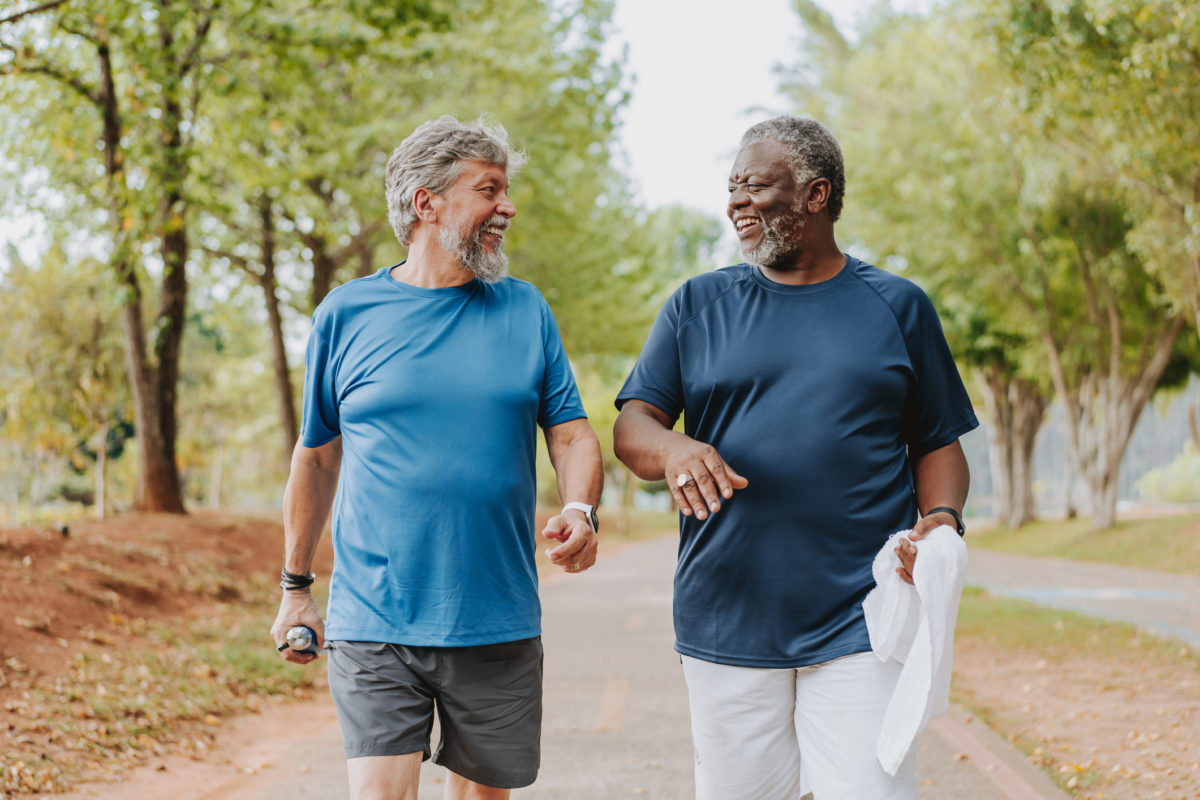Getting started with a walking program
By Mary Anna Rodabaugh
According to the Centers for Disease Control and Prevention, adults aged 65 and older need at least 150 minutes a week of moderate-intensity activity, such as brisk walking.
While this is the recommendation, there are options to consider when starting a walking program. Before you choose to incorporate a walking program into your daily life, be sure to consult with your doctor. “The beautiful thing is you can always initiate the walking program based on your comfort level,” says Melissa Smith, DPT, GCS, CEEAA, geriatric clinical specialist, certified exercise expert for aging adults, and owner of Age Well Physical Therapy.
Many people think walking to a neighbor’s house and doing things around the house is enough to keep the heart healthy. These tasks are not really considered exercise; they are activities of daily living and part of a healthy, active lifestyle. This type of regular activity would not be considered an exercise program. Exercise is purposeful, consistent and should slightly exert the body to get a health benefit, such as increased cardiovascular health, increased endurance, and stronger bones or muscles.
“There are plentiful advantages to walking for promoting healthy aging,” says Alex Bendersky PT, DPT, director of clinical interventions at Luna Physical Therapy. “Walking is a gateway to health by engaging and optimizing multiple bodily systems through low-impact physical activity. Developing a tolerance for walking various distances enhances well-being, adds health value for seniors and fosters healthy aging.”
Getting started
Check with your health care provider prior to starting a walking program. Take all your prescribed medications as usual. If you require emergency medications or oxygen, be sure to bring these items with you on your walk.
Smith says that once cleared by your physician to initiate a walking program, there are a few things to consider: safety, duration, intensity and consistency.
Choose supportive and comfortable walking shoes. You want shoes with good traction, shock absorption and plenty of support. For anyone who uses an assistive walking device, bring it along for your walk.
Decide if you want to walk inside, outside or near your home. If you have mobility challenges, you can walk in place while holding onto a walker, countertop or sturdy piece of furniture, lifting your knees as high as you can.
When walking outdoors, select a location that is quiet with minimal distractions. A busier environment will have more noise and distractions, which can increase the risk of falls or accidents. If you are able to drive or travel to a walking location, a soft track is ideal to prevent excess pressure on your joints.
Before and after each walk, perform gentle stretches to warm up your muscles and prevent stiffness and soreness, recommends Eric Ramos, certified personal trainer and senior group fitness instructor.
Duration
“Don’t make it too hard the first time,” Smith says. “Take it easy and get your body used to it.”
Smith suggests finding your baseline status. Start walking at a comfortable pace and time yourself. Stop walking when you feel tired. Stick to that duration for about a week until you feel comfortable to increase your walking time.
“If you feel comfortable and you feel your body is ready, maybe add another 30 seconds,” she says.
Intensity
There are three levels of physical intensity: low, moderate and high. If you are walking at a low intensity, you should be able to carry a conversation with ease.
Walking at a moderate intensity will increase your heart rate, so you will not be able to carry on a regular conversation. You may be able to say a few words, but your breathing will be more rapid. At moderate intensity, you should still be comfortable enough so you do not have to stop to catch your breath.
“Most aging adults are doing something in the low to moderate intensity,” Smith says. “If you are someone with cardiovascular disease, it is always best to start with low-intensity exercise.”
Moderate intensity is best for cardiovascular health. It is most effective in improving the function of heart muscles and increasing the ability of your lungs to work better.
Unless you are trying to lose weight or improve endurance, it is not necessary to workout at high intensity. You will see this level with athletes who are training for a sport, and it may leave you gasping for air.
Make walking work for you
Set achievable goals for yourself, such as walking for a certain amount of time or distance each day or week.
“Celebrate your progress along the way,” says Ramos, who is CEO of Impact Total Fitness in Philadelphia. “Also, listen to your body. Pay attention to how your body feels during and after exercise. If you experience pain or discomfort, adjust your routine accordingly and rest when needed.”
If you don’t enjoy walking alone, you can make it a social activity and invite friends along. If you cannot walk outside due to safety concerns or weather, consider walking around your home or in place. If you have painful joints, consider joining a gym or facility with an indoor pool. You can walk through the water at the pool and eliminate stress on your joints, while still enjoying the benefits of exercise.
Philadelphia Parks & Recreation maintains more than 60 outdoor pools in Philadelphia, which typically begin opening in late June. For information and locations, call 215-683-3600 or go to phila.gov/parks. There are also five YMCA locations in Philadelphia with indoor pools. For information and locations, call 215-918-7453 or go to PhillyYMCA.org.
Older Philadelphians can visit any senior community center to join a walking group or use a treadmill. You can also participate in fitness classes, many led by Ramos. For locations, call the PCA Helpline at 215-765-9040 or go to pcaCares.org/senior-centers.
A walking program will strengthen muscles; help prevent weight gain; lower the risks of falling, heart disease, stroke, diabetes and osteoporosis; and improve balance. If you’re concerned about starting, after speaking with your physician or primary care provider, you can always see a physical therapist for gait training or a balance assessment to get you started.
Mary Anna Rodabaugh is a writer, editor and writing coach.




